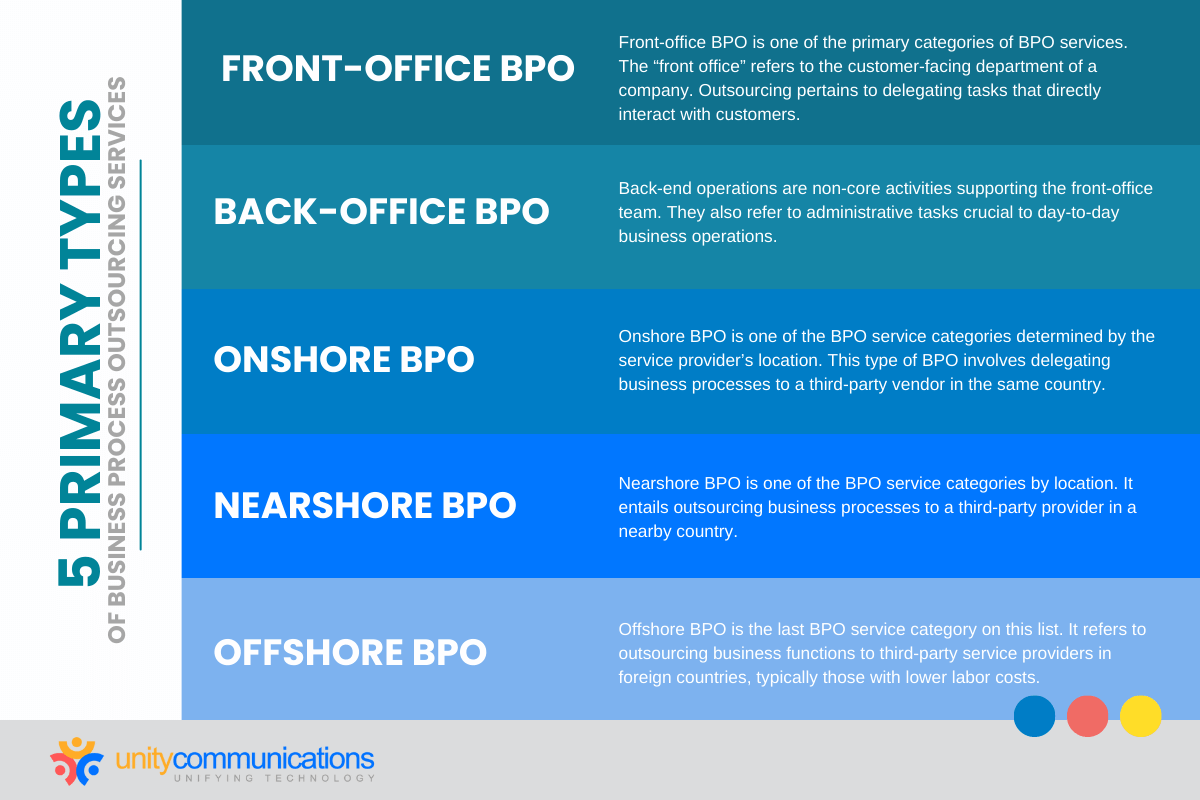Table of Contents
In today’s business landscape, business process outsourcing (BPO) has gained ground. Companies of all sizes outsource front-office and back-end operations. They hire BPO services to:
- Prioritize their core business,
- Save money,
- Increase efficiency,
- Improve quality, and
- Boost profitability.
But did you know that BPO comes in different types? Read on to discover the categories of BPO services so that you can make informed outsourcing decisions.
5 Primary Types of BPO Services

First of all, what is BPO? Simply put, it entails delegating processes to third-party service providers. Small and midsize enterprises (SMEs) and big companies outsource customer service, sales, information technology (IT) support, creative, and administrative functions. Instead of handling these functions in-house, companies entrust them to external vendors.
According to Grand View Research, the BPO market reached almost $262 billion in 2022 and is seen to reach $525.2 billion by 2030. It could expand at a compound annual growth rate (CAGR) of 9.4%, which means that BPO services will continue to be in high demand.
There are five categories of BPO services: Based on function:
Based on the location:
|
Let us expound on each of them below.
1. Front-office BPO: Serving and Supporting Customers
Front-office BPO is one of the primary categories of BPO services. The “front office” refers to the customer-facing department of a company. Outsourcing pertains to delegating tasks that directly interact with customers.
The most common front-office BPO services are:
- Customer service – assisting customers by answering questions, processing requests, and resolving issues
- Sales or telemarketing – reaching out to potential and existing customers to sell your products or services
- Technical support – technical assistance to tech-product end users
Example: A financial and banking institution in the United States outsources its billing and collections to a contact center in the Philippines. The offshore BPO team is responsible for calling clients to collect payments and answering phone billing inquiries. Potential Benefits:
Possible Drawbacks:
Top Recommendations:
|
2. Back-office BPO: Streamlining Business Operations
Back-office BPO, which encompasses ensuring BPO security, is one of the primary categories of BPO services. In contrast to the front office, the back office has no interactions with customers at all. Back-end operations are non-core activities supporting the front-office team. They also refer to administrative tasks crucial to day-to-day business operations.
Some examples of back-office BPO services are:
- Data entry – obtaining, recording, organizing, updating, and securing business, customer, or product information
- Administrative work – including accounting and finance (A&F) services, human resources (HR), and payroll
- Creative tasks – including content creation, graphic design, and web development
Example: An e-commerce startup in the U.S. outsources its data entry, order fulfillment, and supply chain management to an expert provider in the same country. The onshore BPO team has the expertise, technology, and resources to handle these functions. They can help the startup optimize its operations and scale its business. Potential Benefits:
Possible Drawbacks:
Top Recommendations:
|
3. Onshore BPO: Accessing Expertise and Technology
Within the BPO service categories, Onshore BPO distinguishes itself based on the service provider’s location. This form of BPO entails entrusting business processes to a third-party vendor in the same country.
As reported by Clutch, in 2022, nine out of ten small businesses consider outsourcing. In fact, 37% of small businesses outsource at least one business process and 92% of G2000 companies use IT outsourcing alone. This decision is primarily driven by two key factors: the opportunity to collaborate with experts (26%) and the access to adaptable resources (33%).
Example: A perfect example of onshore BPO is when a walk-in clinic outsources its imaging services and laboratory tests to a radiology center and lab clinic. Since the clinic does only medical checkups, it entrusts its diagnostic services to reliable service providers in the area. Potential Benefits:
Possible Drawbacks:
Top Recommendations:
|

4. Nearshore BPO: Saving Money and Enjoying Proximity
Among the location-based BPO service categories, Nearshore BPO stands out. It involves delegating business processes to a third-party provider in a neighboring country.
Deloitte has identified cost reduction as the primary motivation for outsourcing. Companies outsource both front- and back-office functions to minimize labor and operational expenditures. The added advantage of geographic proximity makes nearby countries an appealing choice instead of offshore outsourcing.
Example: A nearshore BPO is a retail business outsourcing its customer support to a service provider in Latin America. The retail company takes this route to ensure it can also assist its Spanish customers. The BPO team of bilingual agents assists its American and Spanish customers. Potential Benefits:
Possible Drawbacks:
Top Recommendations:
|
5. Offshore BPO: Reducing Costs and Scaling Operations
The final category in our BPO services list is Offshore BPO. This entails the practice of outsourcing business functions to third-party service providers in foreign nations, usually selected for their lower labor costs. Organizations embrace offshore outsourcing as a means to achieve long-term cost savings.
Leading offshoring destinations include the Philippines and India, known for their prominence in this field. European nations like Ukraine and Poland also hold a strong presence, particularly in IT services and software development. Distinguishing between nearshore and offshore BPO depends on the provider’s proximity to your country of operation.
Example: A tech giant in the U.S. outsources its IT support services to an IT-BPO firm in India. It employs offshore outsourcing to reduce its labor and operating expenditures. At the same time, this business strategy lets the company tap into IT professionals and experts. Potential Benefits:
Possible Drawbacks:
Top Recommendations:
|
The Bottom Line
The BPO industry has grown and expanded its service scope. Businesses of all sizes can capitalize on the following categories of BPO services:
- Front-office outsourcing
- Back-Office outsourcing
- Onshore outsourcing
- Nearshore outsourcing
- Offshore outsourcing
Understand what these BPO services are and how they work. Weigh their pros and cons before working with a service provider. More importantly, follow our top outsourcing recommendations above.
Looking to hire BPO services? Contact Unity Communications, and let’s connect. We offer various BPO services to businesses of all sizes and across different industries. We are committed to helping your business grow and succeed!




